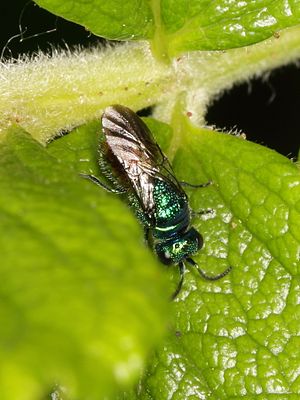Snail Shell wasp
| Snail Shell wasp | ||||||||||||
|---|---|---|---|---|---|---|---|---|---|---|---|---|

Snail shell wasp ( Chrysis trimaculata ) |
||||||||||||
| Systematics | ||||||||||||
|
||||||||||||
| Scientific name | ||||||||||||
| Chrysis trimaculata | ||||||||||||
| ( Forester , 1853) |
The snail shell wasp ( Chrysis trimaculata ) is a species from the family of the golden wasps (Chrysididae).
features
The golden wasps are eight to ten millimeters long. Her head and thorax are green, occasionally blue, and the abdomen is red-gold in color. All colors have a metallic sheen. The tergite of the last abdominal segment is not toothed and has no bulges, which distinguishes this species from the other, otherwise very similar, Chrysis species.
Occurrence
In Central Europe , the animals are mainly found in the mountains, where they can be found in sunny, slightly overgrown areas such as dry grass . They are common and fly from March to June.
Way of life
Snail shell gold wasps live parasitically on mason bee species that build their nests in empty snail shells . Mostly they live with the species Osmia aurulenta . The bee first builds part of the end wall before bringing the food supplies into the house. The golden wasp lays its egg behind the wall, where it cannot be seen by the bee and is then walled in with it. The golden wasp larva clings to the bee larva after hatching and sucks on it. At first, however, this happens with longer pauses, so that the bee larva remains strong enough to develop fully. Only after it has eaten up its supplies and coiled up with the wasp larva to pupate does it eat it up completely. The wasp larva then pupates inside the bee cocoon. The imago of the snail shell wasp hatches in autumn and then hibernates in the snail shell, which is only left in the spring of the following year.
literature
- Heiko Bellmann : bees, wasps, ants. Hymenoptera of Central Europe . Franckh-Kosmos Verlags-GmbH & Co KG, Stuttgart 1995, ISBN 3-440-09690-4 .